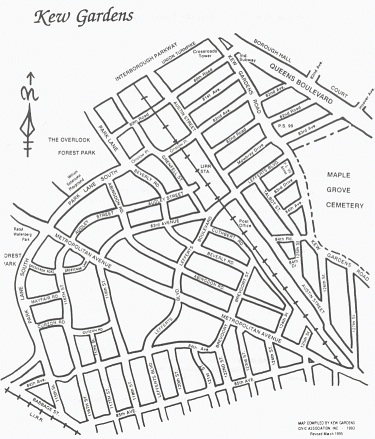Views
Kew Gardens
Kew Gardens is a neighborhood in central Queens, New York. It shares Queens Community District 9 with neighboring areas Richmond Hill, Woodhaven, and Ozone Park.
View Kew Gardens in a larger map
Kew Gardens: "The Urban Village"

| Queens Blvd. by Kew Gardens [1] |
|---|
Stepping out of the subterranean darkness of the E train one is instantly absorbed into the processions of cars, buses and people moving against the commercial backdrop of Queens Boulevard. The busy, urban quality of the scene is as vast and over-stimulating as any other main commercial thoroughfare in the outer boroughs. Adding to this atmosphere are the Boulevard’s commercial buildings and the large, stately Borough Hall, which stands adjacent to the Kew Gardens Interchange, a complex intersection of roads. However, upon turning down a side street on the southbound side of the Boulevard, one is pleasantly surprised, even taken aback, by the stark contrast in scenery. The wide, bustling Boulevard, crowded sidewalks and commercial buildings abruptly give way to smaller, winding, country-like roads, where the only sound is the occasional passing of a car. The further one walks into this community, the more distant the memory of Queens Boulevard becomes. Appealing, well-maintained private houses, built in a variety of architectural styles, are framed by lush, green lawns, gardens, and the pin oaks that line each street. This sense of escape from urban life, along with the calm, garden-suburb atmosphere of the neighborhood, are precisely what the Man family, who planned and developed the community of Kew Gardens in the early 20th century, aimed to create. Kew Gardens, which architectural historian Barry Lewis deems an “urban village in the big city”, has served as a home and community for the upscale, the middle class, various celebrities throughout the 20th century, and several different waves of immigrants from varied origins. The residents, and particularly the architecture, of Kew Gardens have perpetuated the neighborhood’s individual quality since it’s inception.

| A street map of Kew Gardens drawn up by the Kew Gardens Civic Association in 1995 [2] |
|---|
References
- ↑ De May, Joseph. A Picture History of Kew Gardens. April 26, 2009. Website. (http://kewgardenshistory.com/ss-queensblvd/qb-0600-NL.html)
- ↑ De May, Joseph. A Picture History of Kew Gardens. April 26, 2009. Website. (http://kewgardenshistory.com/index/maps.html)